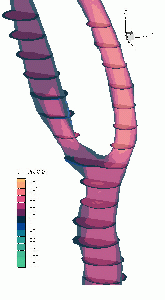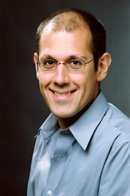
|
 David A. Steinman, Ph.D.
David A. Steinman, Ph.D.
The Biomedical Simulation Lab.
"Research interests in Hemodynamics Factors in Atherogenesis,
Improving Stroke Risk Assessment,
Optimization of Bypass Graft Surgery,
Virtual MRI and Doppler Ultrasound,
Visualization of Pulsatile Flow,
3D Reconstruction of Vascular Anatomy, and
Turbulence and Pulsatile Flow."
|
 Danny Bluestein, Assistant Professor
Danny Bluestein, Assistant Professor
Department of Biomedical Engineering, SUNY Stony Brook
"My primary research interests are in biofluids and
cardiovascular pathologies. I am
studying blood flow in the cardiovascular system, with a
special interest in flow induced
cardiovascular pathologies, and the design optimization of
cardiovascular prostheses. I
envision to bring recent advancements made in various fields,
namely numerical
modeling, non-invasive flow measurement techniques, and
innovative blood
measurement techniques, to better understand the mechanisms
underlying
cardiovascular pathologies such as stenoses, aneurysms,
thrombus formation, and
pathological flow fields past prosthetic heart valves and
various blood recirculating
devices that may lead to cardioembolic strokes."
|
 George Biros, Associate Professor
George Biros, Associate Professor
College of Computing and College of Engineering, Georgia Institute of Technology
"George Biros's research interests include parallel computing, integral and differential equations,
inverse problems, biological complex fluids, soft tissue and cardiovascular mechanics, and medical image analysis "
|
 Daniel D. Joseph, Professor, Regents and Russell J. Penrose Professor Emeritus
Daniel D. Joseph, Professor, Regents and Russell J. Penrose Professor Emeritus
Aerospace Engineering and Mechanics, University of Minnesota
""
|
 Michael R. King, Associate Professor
Michael R. King, Associate Professor
Chemical Engineering, University of Rochester
"The King laboratory seeks to understand all aspects of the dynamic interactions between blood,
circulating cells, and the tissues that they contact. In particular, the balance between
hydrodynamic shear forces and chemical adhesive interactions presents the most scientifically
interesting aspect of this field currently, as well as being an area with great potential to
impact public health through its relevance to cancer, cardiovascular disease, and inflammation.
The ultimate goal of our laboratory is a complete, predictive numerical simulation of blood
flow that includes all relevant cellular interactions. The surface interactions between cells
in suspension or between suspended cells and the vessel wall is where we stand to make the
largest contribution to the field, as a rigorous treatment of particulate flow in a
biologically realistic setting has never been previously attempted. One of the greatest
challenges that we have faced and will continue to address is the need to bridge multiple
length scales: from deviation bond lengths measured at tens of nanometers, to micron-sized
blood cells, to larger vessels several millimeters in diameter. Continuum rheological models
at the artery scale must be matched in a seamless way with the multiparticle adhesive dynamics
(MAD) simulation that is able to consider nearfield interactions during cell-cell or cell-wall
collisions. We have already succeeded in reconciling bond compliance and kinetics in a
cellular-scale calculation. Our research will progress from code development and in vitro
experimentation, to later comparison of MAD with experimental animal models, to finally
correlating MAD results to patient data. "
|
 Aaron Fogelson, Professor
Aaron Fogelson, Professor
Department of Mathematics, University of Utah
|
|
